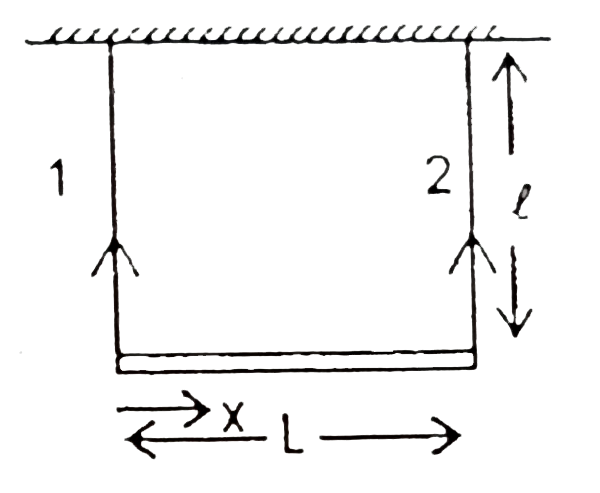Three strings of equal lengths but stretched with different tensions are inade to vibrate. If their masses per unit length are in the ratio 1:2:3 and the frequencies are the same, calculate the ratio of the tensions.
The correct Answer is:1:2:3
To solve the problem, we need to find the ratio of tensions in three strings that have the same length but different tensions and different masses per unit length, while their frequencies are the same.
1. Understanding the Given Information:
- Let the tensions in the three strings be T1,T2,T3.
- Let the masses per unit length of the three strings be m1,m2,m3.
- The ratio of the masses per unit length is given as m1:m2:m3=1:2:3.
2. Using the Frequency Formula:
- The frequency f of a vibrating string is given by the formula:
f=1L√Tm
- Since the lengths of the strings are the same, we can simplify this to:
f=√Tm
3. Setting Up the Equations:
- Since the frequencies of all three strings are the same, we can write:
√T1m1=√T2m2=√T3m3=k
- Where k is a constant.
4. Squaring the Equations:
- Squaring the equations gives us:
T1m1=T2m2=T3m3=C
- Where C is another constant.
5. Expressing Tensions in Terms of Masses:
- From the above equations, we can express the tensions in terms of the masses:
T1=C⋅m1,T2=C⋅m2,T3=C⋅m3
6. Finding the Ratio of Tensions:
- The ratio of the tensions can now be expressed as:
T1:T2:T3=m1:m2:m3
- Substituting the given ratio of masses:
T1:T2:T3=1:2:3
Final Answer:
The ratio of the tensions in the three strings is T1:T2:T3=1:2:3.
---
- Let the tensions in the three strings be T1,T2,T3.
- Let the masses per unit length of the three strings be m1,m2,m3.
- The ratio of the masses per unit length is given as m1:m2:m3=1:2:3.
- The frequency f of a vibrating string is given by the formula:
f=1L√Tm
- Since the lengths of the strings are the same, we can simplify this to:
f=√Tm
- Since the frequencies of all three strings are the same, we can write:
√T1m1=√T2m2=√T3m3=k
- Where k is a constant.
- Squaring the equations gives us:
T1m1=T2m2=T3m3=C
- Where C is another constant.
- From the above equations, we can express the tensions in terms of the masses:
T1=C⋅m1,T2=C⋅m2,T3=C⋅m3
- The ratio of the tensions can now be expressed as:
T1:T2:T3=m1:m2:m3
- Substituting the given ratio of masses:
T1:T2:T3=1:2:3
The ratio of the tensions in the three strings is T1:T2:T3=1:2:3.
Topper's Solved these Questions
- WAVESBOOK - ICSECHAPTER - WAVESEXERCISE - From Organ Pipes
22 Videos
- WAVESBOOK - ICSECHAPTER - WAVESEXERCISE - From Beats
15 Videos
- WAVESBOOK - ICSECHAPTER - WAVESEXERCISE - Selected Problems (From Wave Equation, Intensity , Energy Density)
24 Videos
- VECTORS SCALARS ELEMENTARY CALCULUS BOOK - ICSECHAPTER - VECTORS SCALARS ELEMENTARY CALCULUS EXERCISE - UNSOLVED PROBLEMS
79 Videos
Similar Questions
The masses of three copper wires are in the ratio 2:3:5 and their lengths are in the ratio 5:3:2. Then, the ratio of their electrical resistance is
View SolutionThe masses of the three wires of copper are in the ratio 5:3:1 and their lengths are in the ratio 1:3:5. The ratio of their electrical resistances is
View SolutionThe masses of the three wires of copper are in the ratio 5:3:1 and their lengths are in the ratio 1:3:5. The ratio of their electrical resistances is
View SolutionTwo different stretched wires have same tension and mass per unit length. Fifth overtone frequency of the first wire is equal to second harmonic frequency of the second wire. Find the ratio of their lengths.
View SolutionDerive an expression for the velocity of pulse in a in stretched in string under a tension T and μ is the mass per unit length of the sting.
View SolutionTwo wires of the same material and length are stretched by the same force. Their masses are in the ratio 3:2. Their elongations are in the ratio
View SolutionTwo strings of copper are stretched to the same tension. If their cross-section area are in the ratio 1 : 4 , then the respective wave velocities will be
View SolutionTwo vibrating strings of same material stretched under same tension and vibrating with same frequency in the same overtone have radii 2r and r. Then the ratio of their lengths is:
View SolutionTwo strings of the same length but different mass per unit length are used to suspend a rod whose density varies as ρ=ρ0[1+αx] as shown in the figure. The frequency of standing waves produced in the string is in the ratio n:1, when both the strings are vibrating in their fundamental mode. If the mass per unit length of string (l) is μ0, calculate the mass per unit length of the other string.

View SolutionTwo strings of same material are stretched to the same tension . If their radii are in the ratio 1:2 , then respective wave velocities in them will be in ratio
View Solution
